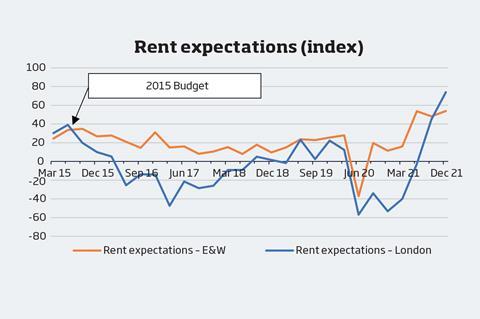London rental levels have finally shaken off the curse of George Osborne, with agents now foreseeing residential rents in the capital rising faster than the rest of the country for the first time since the ex-chancellor’s 2015 Budget put the kibosh on the sector for close on seven years.

Osborne signalled a swathe of tax hikes in his July 2015 Budget, starting with a heavy reduction in mortgage tax relief for many private landlords. This had the potential to turn profitable portfolios loss-making.
The impact on rents was immediate. A month earlier, the quarterly RICS Residential Market Survey showed that agents in London had expected rents to rise faster than in England and Wales as a whole. Following the announced tax change, to be phased in over four years, expectations nosedived.
The chart above shows the ‘index’ of survey respondents’ expectations – the percentage expecting a rise minus those predicting a fall. For Q2 2015, London registered 39% against 34% for England and Wales.
Then came the Budget, followed by a seemingly interminable series of broadsides, which disproportionately hit the capital’s private landlords. It showed rents mainly falling until mid-2021, while the country as a whole cantered along at a healthy positive balance of around 20% to 40%.
There were further tax hikes – such as ‘wear and tear’ allowances and a 3% stamp duty surcharge for investment properties. This was on top of an overall rejig of stamp duty, which had an impact on higher-priced London properties more than in the rest of the country.
The government then slapped a rapid succession of regulations on landlords, such as restrictions on deposits that landlords could hold; pressure for longer break periods in tenancies; the requirement for EPC energy ratings of ‘E’ or above; even bans on requiring ‘pet deposits’. One could be forgiven for concluding that the government ‘had it in for’ private landlords.
Slow car crash
Actually, it looks like it did. In my July 2018 column, I quoted a Conservative councillor who confided that a former housing minister had told him: “We don’t want ‘moms and pops’ running the housing market.”

A slow car crash unfolded during the phased four-year removal of mortgage interest tax relief. Homes owned within a company structure, rather than by those moms and pops, were not affected by the cut in interest relief.
In theory, private buy-to-let (BTL) investors could set up companies and transfer their properties into them. However, these transfers could incur capital gains tax and the newly hiked stamp duty. Both particularly hit the higher-priced London market. Many ‘asset-rich, cash-poor’ private landlords with multiple properties faced the prospect of having to sell some of their homes into the owner-occupier market, incurring one-off capital taxes in order to reduce ongoing taxes on income in the rest of their portfolios.
As if this was not enough pain, along came predictions of a ‘Brexodus’ of financial workers (ultimately something of a non-event), massive over-building of speculative apartments and then travel bans during the pandemic.
Then something happened. I first heard chat of a revival at Property Week’s RESI Convention last September. The RICS data appears to confirm this. The index for London turned positive in Q3 at 45%, just shy of 48% for England and Wales. Then the chart rose almost vertically in Q4: 74% for London, eclipsing the 54% for the whole country – both 20-plus-year records for arguably the sector’s most influential survey.
It seems you cannot keep a great city down forever. The tax rises appear to have been priced in to sales prices. Thousands of private landlords have thrown in the towel and the construction of new apartment blocks has waned. The survey also shows that tenant demand has recovered to record levels.
But it is likely to be a very different rental sector going forward, with build to rent (BTR) eclipsing BTL. The sums had not quite stacked up for BTR in the capital, with rents rarely justifying the dizzy price of land, forcing institutional investors to look to regional cities. Where the moms and pops (and speculative developers) have left, international big-gun investors have arrived. The only problem is a lack of new stock.
Alastair Stewart is an equities analyst and consultant





























1 Readers' comment